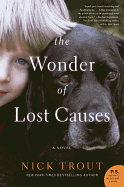
| Publisher: | Morrow | |
| Genre: | Animals, Family Life, General, Coming of Age, Fiction | |
| ISBN: | 9780062747945 | |
| Pub Date: | April 2019 | |
| Price: | $16.99 |
| Starred | Fiction |
by Nick Trout
Nick Trout (Dog Gone, Back Soon; The Patron Saint of Lost Dogs) delivers a beautifully written, poignant story infused with gentle humor and compassion. Jasper Blunt is a precocious, very lovable 11-year-old battling cystic fibrosis and its complications. Kate, Jasper's hardworking single mother, is struggling to keep her son healthy and make ends meet while working hard as a rescue shelter veterinarian on Cape Cod in Massachusetts.
When a mysterious and badly abused dog arrives at the shelter with health problems of his own, Jasper and the dog form an instant bond--the dog looks out for the boy, who intuitively knows what the dog is feeling. Jasper claims he can communicate with the mutt and even believes the dog told him his name, Whistler. This intrigues yet worries Kate. Might Jasper, plagued with breathing problems, hearing loss and a host of other ailments, also be growing delusional? When Jasper lobbies Kate to adopt Whistler, she resists. After all, their apartment building does not permit pets. But when Whistler's background and his true origin are ultimately discovered, Jasper and Kate face a big decision that takes them on an adventurous journey. Might the Blunts need Whistler as much as he needs them?
Trout's well-paced narrative is filled with big, resonant scenes that render the story surprisingly suspenseful. As Whistler's history unfolds via the points-of-view of Jasper and Kate, revealing their innermost thoughts and fears, the mother-son bond deepens. This tender, inspirational story--forged with themes of deliverance and hope--overflows with profound meaning. --Kathleen Gerard, blogger at Reading Between the Lines

| Publisher: | New Directions | |
| Genre: | Psychological, Classics, Urban, Literary, Fiction | |
| ISBN: | 9780811228428 | |
| Pub Date: | April 2019 | |
| Price: | $11.95 |
| Fiction |
by Yukio Mishima, trans. by Sam Bett
In Yukio Mishima's unsettling novella Star, Rikio Mizuno is a 23-year-old sex symbol in high demand, starring in back-to-back films. On location for his newest movie, his fans can hardly contain themselves just beyond the roped-off set. It's not a particularly innovative screenplay, though--crime, lust and betrayal in the life of a young yakuza. "There are too many movies like this to count.... But there's something timeless about the mediocrity of the story, no matter how many times I find myself inside of it." Musing as much on the sentimental arc of gangster films as that of celebrity artifice, Mishima draws readers' attention to "a hidden poetry that evaporates if but one strip of mediocrity is shed." He seems more interested in proving the genres' resilience than breaking new ground within them.
Rikio is discontent with his fame, but woe to anyone who might take pity on him for it; his response will be to play up his complacent naivete. His assistant Kayo is the only person he allows to see his faulty interior. She is his perfect foil: aging, homely and ignored by everyone. Cruel and impish, Kayo relishes the disdain of the world: "She boasted of her flaws as if they were an asset." And her greatest asset of all is the secret sexual relationships she and Rikio are carrying out.
Star is a sleek dalliance with the pitfalls of celebrity, and the translation captures a kinesthetic sense of prose, such as "a long, hyperactive nose" and a floor that "twinkled wet from everyone's umbrellas." It is a familiar story whose execution is hardly mediocre. --Dave Wheeler, associate editor, Shelf Awareness
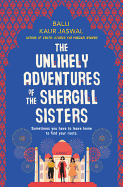
| Publisher: | Morrow | |
| Genre: | Women, Cultural Heritage, Asian American, Fiction | |
| ISBN: | 9780062645142 | |
| Pub Date: | April 2019 | |
| Price: | $26.99 |
| Fiction |
by Balli Kaur Jaswal
When Sita Kaur Shergill was alive, her three British-born daughters didn't always obey her; in death, she demands total surrender. Sita's last wish was for her daughters to scatter her ashes in India, her homeland. She even left them a travel itinerary. As middle sister Jezmeen, a D-list London actress, interprets her mother's actions, "the trip was less about spirituality and more about Mum forcing them to travel together."
The Unlikely Adventures of the Shergill Sisters often reads like a travel narrative, with points of view wandering as the sisters do, taking in (per Mum's orders) India Gate and the Golden Temple. Meanwhile, the sisters consider their respective burdens. Jezmeen has a doozy: she has become an international laughingstock since a video of her recent tantrum at a London restaurant went viral.
Jezmeen's troubles are as public as her sisters' are private, and chapters abound with clues about Rajni's and Shirina's secrets. (They're revealed toward the book's end.) For Rajni, the trip stirs bad memories of something that happened the last time she went to India, when she was a rebellious teenager traveling with her newly widowed mother. And Shirina, who arranged her marriage through a Sikh matrimonial website, is concealing from her sisters both her unhappiness at home in Australia and the reason for her weight gain.
As she did in Erotic Stories for Punjabi Widows, Balli Kaur Jaswal explores the perks and prices of assimilation that are particular to women from traditional cultures, spiking her narrative with brilliant screwball-comedy touches. --Nell Beram, author and freelance writer
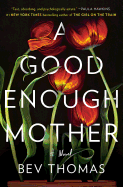
| Publisher: | Pamela Dorman/Viking | |
| Genre: | Women, Family Life, General, Thrillers, Fiction | |
| ISBN: | 9780525561255 | |
| Pub Date: | April 2019 | |
| Price: | $26 |
| Fiction |
by Bev Thomas
Bev Thomas was a clinical psychologist for the U.K. National Health Service for many years, and her debut novel echoes that experience: her tense psychological thriller, A Good Enough Mother, features a therapist in London.
Ruth Hartland is good at her job, helping patients cope with horrible traumas. Underneath her calm, professional exterior, though, Ruth has been traumatized. Her beloved son, Tom, who always struggled to fit in, disappeared without a trace more than a year ago, before his 18th birthday. Ruth is still living in crisis, though most people at work don't know about Tom. When Dan, a new patient, comes to Ruth needing help after an assault, she is shocked by how much he resembles her son. She knows she should refer him to another therapist, but she feels compelled to help this stranger who reminds her of Tom. As the two begin to work together, Ruth's professional limits continue to erode, and her own feelings of guilt and sorrow get in the way of helping Dan.
Tension slowly builds in this gripping story, as details of both Ruth's and Dan's pasts gradually come to light. In his sessions, Dan reveals not only the recent incident that brought him to Ruth but also childhood traumas, while Ruth remembers both good times and bad in Tom's childhood. A pervasive feeling of dread grows as lines are crossed and boundaries are blurred in this compelling and suspenseful novel that delves into trauma, family and motherhood. --Suzan L. Jackson, freelance writer and author of Book By Book blog
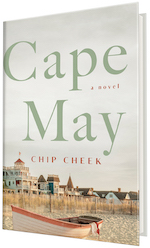
| Publisher: | Celadon Books | |
| Genre: | Women, Small Town & Rural, Family Life, General, Literary, Marriage & Divorce, Fiction | |
| ISBN: | 9781250297150 | |
| Pub Date: | April 2019 | |
| Price: | $26.99 |
| Fiction |
by Chip Cheek
It is late September 1957. Newlyweds Effie and Henry have traveled from their small Georgia town to Cape May, N.J., for their honeymoon, only to find themselves in a nearly deserted seaside resort. When compared with her nostalgic memories of summers at her uncle's Cape May home, the ghostly atmosphere is a disappointing reality for Effie, who "had not understood what 'off-season' meant."
Feeling unmoored and sexually uncertain with each other, the young couple--Effie is 18, Henry is 20--are on the verge of leaving early when they meet Clara, a vivacious Manhattan socialite who remembers Effie from their childhood summers. Several gin and tonics later, Effie and Henry have become enamored with Clara and her inner circle, one that includes her wealthy and gregarious lover, Max, and his beautiful but aloof half-sister, Alma.
Being away from everything and everyone they know in Georgia provides Effie and Henry with a false sense of invisibility and invincibility, the irresistible thrill of remaining hidden while testing boundaries, limits and each other's trust. As Effie and Henry's morals, inhibitions and innocence become untethered, they don't realize that their young marriage has approached a dangerous point of no return.
That precipice makes for an especially compelling and shocking story, one that debut novelist Chip Cheek tells with exceptional symbolism and foreshadowing. There is a film noir quality to the tense narrative that brings the reader immediately into the isolated setting and time period. The heightened sense of danger and foreboding is well supported by Cheek's decision to place Cape May in the fall of 1957. At a large dinner party Clara hosts, the conversations are about the threats from the Soviets. "Always there was something about the Soviets. Korea, outer space, the threat of nuclear war." Henry speculates that some of the guests may even be "covert Communists, of the sort that had supposedly infiltrated the upper echelons of American society." Rather, the real danger lurks within each character's soul. No one is the person we once believed and hoped they were. Everyone is flawed, and tragically so. Having been raised near Flannery O'Connor's hometown of Milledgeville, Ga., Cheek's strong Southern gothic influences are the real deal.
In Cape May, the small details--the kind that reward and thrill careful readers because they signify greater meaning--are among Cheek's strengths. Before meeting Clara, Max and Alma, Henry is reading James Boswell's The Life of Samuel Johnson, "which his Uncle Carswell had given him as a wedding present. Carswell had read it when he was a young man, and it had been a good guide to him, he said. 'You're always going to be at work on yourself, son, and it's always going to be a struggle. But it's the struggle that'll make you a good man.' Henry liked the ideas; he had a vision of the kind of man he wanted to be--virtuous, humble, strong, and bold, full of good cheer but in healthy moderation--and he was eager to learn."
Duplicity and transformation of the self is at the heart of Cape May. Henry's struggle to be a good man is immediately tested on his honeymoon at a moment of betrayal coinciding with his and Effie's sexual awakenings. In Cape May, Cheek shows that every couple encounters such a moment of their own--whether physical, emotional or some combination of both--and it holds the power to change a relationship forever. --Melissa Firman

| Publisher: | Sourcebooks Casablanca | |
| Genre: | Romance, Contemporary, Fiction | |
| ISBN: | 9781492655992 | |
| Pub Date: | April 2019 | |
| Price: | $7.99 |
| Romance |
by Samantha Chase
The Shaughnessy brothers have found their true loves, but the rest of the family is still looking. Though Samantha Chase's series is up to its seventh book, this twist on the series is a perfect entry point for new readers.
Teagan, a cousin of the brothers, thought her chance at love had passed. When her fiancé died during active duty, leaving her pregnant and alone, she threw herself into raising her son, Lucas, and finishing her education. But when she meets Bobby at a family picnic, her instant attraction to him makes her wonder if she's ready to open her heart again. Bobby, a police officer recovering from a gunshot wound, hasn't considered settling down; seeing Teagan's kindness at the picnic makes him think differently.
Teagan and Bobby tip-toe their way into a new relationship, and both have valid concerns. The missteps they make in their courtship are genuine. Bobby is worried about the type of role model he'll be for Lucas, though he's a perfect uncle to his sister Anna and her husband Quinn Shaughnessy's children. Teagan doesn't want to be disloyal to the memory of her fiancé and is also worried about the dangers Bobby's job as a police officer could bring to their possible family--plus, he's known for playing the field. Tangled Up in You is a sweet story of two people trying to find their way through a difficult situation with love, compassion and family, all set against the serene backdrop of the Carolina coast. --Amy Dittmeier, adult services librarian, Brookfield Public Library, Ill.

| Publisher: | Clarkson Potter | |
| Genre: | Biography & Autobiography, Contemporary Women, Biography & Memoir, Emigration & Immigration, Nonfiction, General, Social Science, Comics & Graphic Novels | |
| ISBN: | 9780525575115 | |
| Pub Date: | April 2019 | |
| Price: | $16.99 |
| Graphic Books |
by Malaka Gharib
Malaka Gharib's graphic memoir, I Was Their American Dream, is many things in one entertaining book: an immigrant story, a coming-of-age story, a cultural education and a critique of American whiteness. Gharib, a Washington, D.C., journalist and artist, is a first-generation Filipino Egyptian American. The book's immigrant story is that of her parents, her mom hailing from the Philippines and her dad from Egypt. The title refers to their attempt to build the American Dream, as demonstrated in the opportunities they create for Malaka. Though the parents divorce--and her father moves back to Egypt--they still help their daughter through the strange experience of growing up American.
This graphic memoir balances delightful drawings with humorous and down-to-earth captions. It proves a great vehicle with which Malaka can navigate the complexities of her identity, from her upbringing in a diverse high school in California to challenges she later faces in a mostly white college in New York. Malaka is both attracted to and wary of white culture, the way it assumes its own superiority in adult life. She meets and falls in love with a white man named Darren, but makes a valiant effort to preserve and practice her different cultural heritages in their shared lives. The book features fun and informative games and trivia that add to the narrative. Perhaps the cleverest is a "microaggressions" bingo game that details all the many ways white people mangle issues of race and ethnicity, knowingly and unknowingly.
I Was Their American Dream is a book that celebrates both differences and similarities between people, and for that reason rings true with a sense of humanity. --Scott Neuffer, writer, poet, editor of trampset
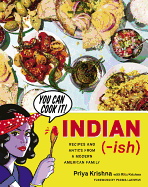
| Publisher: | Houghton Mifflin Harcourt | |
| Genre: | Indian & South Asian, Comfort Food, Cooking, Regional & Ethnic | |
| ISBN: | 9781328482471 | |
| Pub Date: | April 2019 | |
| Price: | $28 |
| Food & Wine |
by Priya Krishna, Ritu Krishna
Having written for the New York Times, the New Yorker and Bon Appétit, Priya Krishna grants that "being a food writer is a Very. Cool. Job." With Indian-ish: Recipes and Antics from a Modern American Family, co-written with her mom, Ritu, this effervescent food writer has written a Really. Great. Cookbook.
"Indian-ish" describes the Krishnas' food and identities, a dynamic blend of Indian and American. As a kid in Dallas, Tex., Krishna was acutely aware of being different from her mostly white peers: "Most of my friends had straightened brown hair (mine was black and frizzy) [and] ate turkey-and-mustard sandwiches for lunch (Mom packed me dal until I begged her to switch to PB&Js." But eventually, Krishna grew to crave the quick, creative meals her mom served up every day. Cue Indian-ish.
Where to start? Dahi Toast, a crunchy-tangy answer to a grilled cheese. For a crowd, Matar Paneer. Other standouts: Roti Pizza and Tomato Rice with Crispy Cheddar (dubbed by the cookbook's photographer "even better than pizza." The vast majority of the ingredients are inexpensive and easily accessible. For any that aren't, Krishna makes allowances. "No paneer? No problem!" Use feta, as in Spinach and Feta Cooked Like Saag Paneer. For non-vegetarians, there's one chicken and three fish recipes.
Save room for dessert--but plan ahead. Shrikhand (sweet saffron-perfumed yogurt) and Quinoa Kheer (rice pudding with a quinoa twist) require long chilling times. For more immediate gratification, make Boozy Strawberries and serve them with Dahi Cheeni Chawal (Sweetened Yogurt Rice) and call it your own Indian-ish dessert. Krishna would approve. --Katie Weed, freelance writer and reviewer
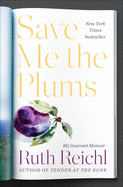
| Publisher: | Random House | |
| Genre: | Biography & Autobiography, Women, Cooking, Personal Memoirs, Culinary, Essays & Narratives | |
| ISBN: | 9781400069996 | |
| Pub Date: | April 2019 | |
| Price: | $27 |
| Starred | Biography & Memoir |
by Ruth Reichl
In a dusty used bookstore, eight-year-old Ruth Reichl gazed dreamily at the swordfish in her hands. It was on the cover of Gourmet, and she was hooked. Some four decades later, Reichl (Tender at the Bone, Garlic and Sapphires) became editor-in-chief of that magazine, until it shuttered in 2009. In Save Me the Plums: My Gourmet Memoir, she dishes on what went wrong (and, for a long time, went right) in her decade at the magazine's helm, sharing recipes from along the way.
A New York City native with an abiding hippie streak, Reichl has been long beloved for her witty, unpretentious food writing. Though Gourmet flatly rejected the one article she pitched to them when she was starting out, others courted her--first the Los Angeles Times, then the New York Times, where she was a restaurant critic. Finally, Gourmet called with the big offer: editor-in-chief.
Reichl accepted nervously, and spares no ego about her rough start, despite the prestige and perks of the job (car, driver, clothing allowance). Hurdles arose by the dozens, but she learned fast. Soon the magazine that many were dismissing as elitist and out-of-touch became again accessible, viable and culturally significant.
Rich with reflection, the memoir is classic Reichl: deeply personal, often funny, sometimes disillusioned. The book's final recipe, a German Apple Pancake, ends: "Spoon the liquor over the top, and set the pancake on fire." But then, if you're like Reichl, plan to come out of the flames all the wiser. --Katie Weed, freelance writer and reviewer
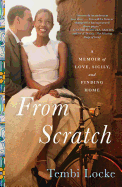
| Publisher: | Simon & Schuster | |
| Genre: | Biography & Autobiography, Travel, Europe, Personal Memoirs, Culinary, Italy | |
| ISBN: | 9781501187650 | |
| Pub Date: | April 2019 | |
| Price: | $26.99 |
| Biography & Memoir |
by Tembi Locke
It may sound familiar: an American woman goes to Italy, indulges in love, wine and good food, and leaves sensually and spiritually transformed. But while this template technically describes From Scratch: A Memoir of Love, Sicily, and Finding Home, Tembi Locke's story is different from ones you've heard before.
Locke, now a Hollywood actor, met Sicilian chef Saro while studying in Florence as an undergraduate in the early '90s. Their connection was immediate, and they married soon after. Over the next 20 years, they made a home in Los Angeles, adopted a daughter and lived a happy, beautiful life together nourished by love and Saro's transcendent cooking. But, from the beginning, heartbreak lurked beneath the surface. The first was that Saro's deeply traditional family disapproved of him marrying a black American woman and refused contact with the couple for years. The second heartbreak--one that, unlike the estrangement, couldn't be overcome--was cancer, and in 2012, Saro died after the recurrence of a malignant tumor that had first appeared 10 years before.
Undone by grief, but determined to forge a new life for herself and her young daughter, Locke begins the slow, painful work of healing. For Locke, this means traveling to Saro's home village and communing with her also-widowed mother-in-law, Croce. Over the course of three Sicilian summers, Locke and Croce--two women of vastly different experience--come to share a profound intimacy and a fuller understanding of the man they both loved.
Locke's resilience and persistence in the face of such loss is incredibly moving, and readers will want to eat the meals she describes right off the page. --Hannah Calkins, writer and editor
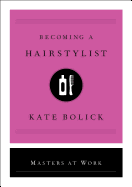
| Publisher: | Simon & Schuster | |
| Genre: | Self-Help, Personal Growth, Biography & Autobiography, Education, Counseling, Business & Economics, Careers, General, Career Development, Success | |
| ISBN: | 9781982115906 | |
| Pub Date: | April 2019 | |
| Price: | $18 |
| Business & Economics |
by Kate Bolick
Gwenn LeMoine is the entrepreneurial force behind New York City's hottest salon, Parlor, with a location in the East Village and one in downtown Brooklyn. Her clientele has included film and literary star Molly Ringwald, TV icon Rue McClanahan and international singing sensation Adele. "Parlor is a haven of individuality, inclusivity, and comfort," explains Kate Bolick (Spinster), drawing attention to the shop's welcoming environment for the particular quirks of clients big and small. As part of the Masters at Work series, Bolick's profile of LeMoine is an entry point to the ever-evolving shape of the beauty industry.
Becoming a hair stylist might sound like the easiest thing in the world--after all, isn't beauty school where dropouts go? "Nothing could be further from the truth," Bolick writes. "Nearly every hairstylist I interviewed admitted that beauty school wound up being a lot more difficult than they'd thought it would be." With classes in anatomy, sanitation and chemistry, plus hours and hours of hands-on practice, such an education is rather strenuous. And after graduation, new stylists often need to learn their employing salons' cutting techniques, because schools train for a test that rarely keeps up with fashion trends.
Taking into consideration the historical arc of cosmetology, strides made by legends like Vidal Sassoon and Horst Rechelbacher and the landscape of gender politics, Becoming a Hair Stylist is a slim yet robust introduction to a thriving trade. "All good hairstylists possess a talent for working with their hands and emotional intelligence" is a maxim Bolick encountered again and again in her research. Interested parties, take note. --Dave Wheeler, associate editor, Shelf Awareness
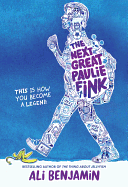
| Publisher: | Little, Brown | |
| Genre: | School & Education, Social Themes, General (see also headings under Family), Juvenile Fiction | |
| ISBN: | 9780316380881 | |
| Pub Date: | April 2019 | |
| Price: | $16.99 |
| Starred | Children's & Young Adult |
by Ali Benjamin
An "evil genius." A "god." An enigma: Paulie Fink, legendary student at the tiny rural Mitchell School, disappeared without a trace after sixth grade. At the beginning of the new school year, before they learn that prankster Paulie is no longer enrolled at Mitchell, the 10 remaining seventh graders eagerly await their mischievous ringleader. When new kid Caitlyn Breen walks into the classroom instead, everyone is disappointed. "Well, you're not Paulie Fink," one girl says. Already upset about moving to "middle of absolutely nowhere" Vermont, Caitlyn is equally dismayed: "This, right here, is probably the most horrifying moment of my life."
Longing to fit in, Caitlyn feels like "some sort of space alien trying to navigate an unfamiliar planet." So when one of the seventh graders suggests that they host a reality-TV-style competition called "The Search for the Next Great Paulie Fink" and make cranky Caitlyn the judge, everyone jumps on board, even Caitlyn. After all, as one classmate says, "Doesn't everybody need a little Paulie Fink in their life?" Caitlyn's Paulie-worthy challenges for the contestants have some exciting and chaotic outcomes. But when the seventh graders learn that, like the retelling of history, all the stories about the "First Great Paulie Fink" are incomplete and subject to perspective, the class comes together in an unexpected, heartwarming, hilarious and human way.
Ali Benjamin (The Thing About Jellyfish) has a phenomenal knack for weaving together seemingly mismatched threads--goats, soccer, pantsuits, bullying, Plato--as if they have every right to be together, making a gorgeous tapestry. The Next Great Paulie Fink is a beautiful, powerful novel about embracing one's own great self, even--or especially--in middle school. --Emilie Coulter, freelance writer and editor
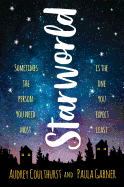
| Publisher: | Candlewick | |
| Genre: | Disabilities & Special Needs, Mental Illness, Family, Social Themes, Young Adult Fiction, Adoption | |
| ISBN: | 9780763697563 | |
| Pub Date: | April 2019 | |
| Price: | $17.99 |
| Children's & Young Adult |
by Audrey Coulthurst, Paula Garner
High school senior Sam Jones hides behind canvasses in the art classroom, games only with her best friend Will and never invites anyone home, where her mother's obsessive-compulsive disorder complicates everything. Left at a safe haven as a newborn, popular student and theater star Zoe Miller believes she's "a mistake"; as her adoptive family faces her mom's battle with cancer and her disabled brother's placement in a residential facility, she struggles to be the "perfect daughter." When Zoe convinces Sam to let her use one of Sam's paintings for a school play backdrop, the two exchange numbers. Slowly, their texted conversation becomes an alternate universe: Starworld. With the "social skills of a potted plant" who would rather "communicate entirely in integrals, surrealist paintings, and spaceship blueprints," Sam can't believe Zoe indulges her game. But the escape gives both the unexpected companionship they need.
Sam and Zoe freely display their eccentricities in Starworld, participating in fanciful antics and divulging deep secrets. Both characters hold admirable desires: Sam wants to enter an aerospace engineering program but fears abandoning her mother; Zoe wants to learn about her roots without upsetting the family she loves. Audrey Coulthurst (Of Fire and Stars) and Paula Garner (Phantom Limbs) tactfully navigate the girls' relationship and Sam's attraction to Zoe as her "Be a robot. Feel nothing" mantra inevitably fails. Told in alternating chapters from each girl's perspective, Starworld extols the value of friendship and shows how self-acceptance can come from being oneself with others. --Samantha Zaboski, freelance editor and reviewer